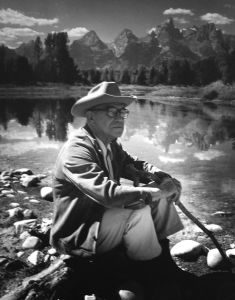
A successful illustrator and studio painter, John Ford Clymer spent his lifetime perfecting some of painting’s most accurate scenes of Western history. Clymer was born in Ellensburg, WA in 1907, where his deep love of nature began. In his early years, much success was found in illustration and advertising on the east coast, eventually leading him to over 80 cover designs for the Saturday Evening Post, second to only Norman Rockwell.
Following years of commercial success with clients like Cosmopolitan, Good Housekeeping, Chrysler, Field and Stream, and New England Life Insurance to name a few, John would eventually back away from illustration to, with a push from his wife, make a historic painting of frontiersmen and Native Americans in bull boats on the Yellowstone River. Upon finishing, John would approach a prestigious gallery in New York City with the piece, where it would sell after just three days on exhibit. This is when John decidedly changed his career path to focus on fine art, and specifically the depicting of the civilization and settling of the Wild West. John and his wife Doris, whose ancestors traveled on the Oregon Trail, did painstaking amounts of research on each painting’s subject, backed by both accounts written in Doris’s family’s journals, and the couples’ visits to the actual scene locations found in John’s work. It was this attention to detail and accuracy that helped John create and share such realistic visuals of early life in the West.
Aside from his majorly successful depictions of western life, Clymer was also an accomplished wildlife painter, and his full studio set up is on permanent display at the National Museum of Wildlife Art in Jackson, WY.
